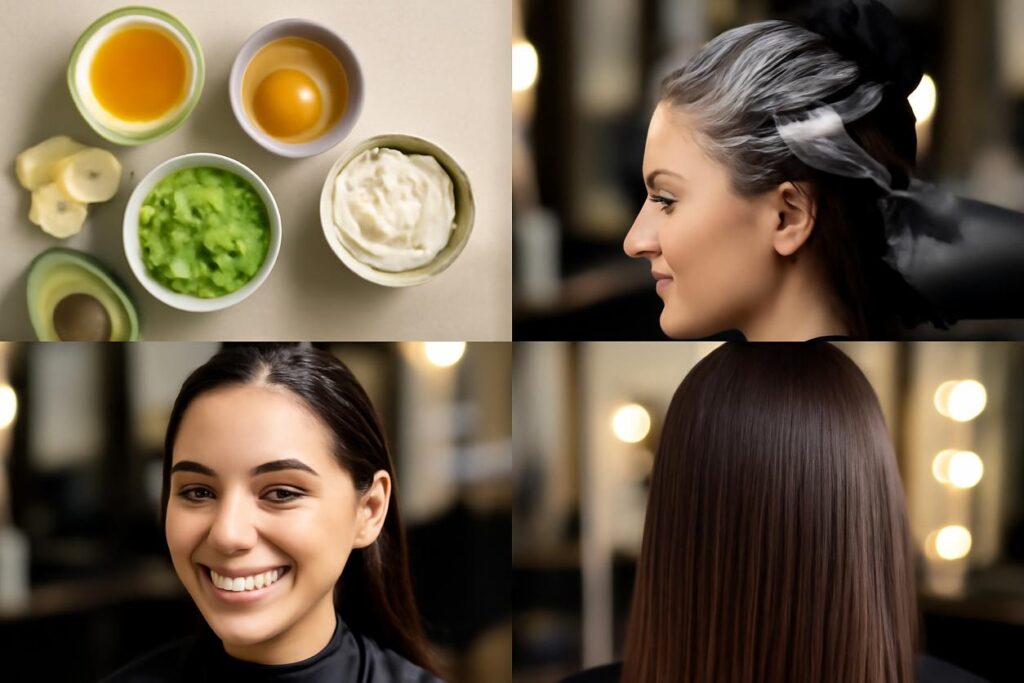Table of Contents
- Understanding Frizz: How Hair Environment and Structure Interact
- Assess Your Hair Type and Porosity
- Daily Morning Steps to Reduce Frizz
- Nighttime Habits That Prevent Morning Frizz
- Targeted Treatments: Masks, Oils and Serums
- Styling Techniques for Long-Lasting Smoothness
- Managing Frizz in Different Climates: Humid and Dry Solutions
- DIY Options: Natural Ingredients and Simple Recipes
- Product Guide: What to Look For and What to Avoid
- Frequently Asked Questions
- Summary and a Daily Frizz Control Checklist
Understanding Frizz: How Hair Environment and Structure Interact
Frizz isn’t just a “bad hair day”—it’s a conversation between your hair and the air around it. To master frizz control, you first need to understand why it happens. Every strand of your hair has an outer layer called the cuticle, which looks like overlapping shingles on a roof. When your hair is smooth and healthy, these shingles lie flat. However, when hair is dry, damaged, or naturally porous, these cuticles lift.
This is where humidity comes in. Air moisture, or humidity, is drawn to dry hair like a magnet. When water molecules from the air penetrate the hair shaft through those lifted cuticles, the strand swells unevenly. This causes it to bend and twist into that familiar frizzy texture. In essence, frizz is your hair reaching out into the atmosphere, desperately trying to grab moisture. The key to effective frizz control is therefore twofold: keeping your hair properly hydrated from within and sealing the cuticle to block excess environmental moisture from getting in.
Assess Your Hair Type and Porosity
A successful frizz control routine isn’t one-size-fits-all. It starts with knowing your hair’s unique characteristics. While you might know if your hair is straight, wavy, or curly, an even more critical factor for managing frizz is its porosity. Porosity determines how well your hair can absorb and retain moisture.
- Low Porosity: The cuticles are tightly packed and lie flat. This hair type resists moisture, making it hard to get products to absorb. It’s less prone to frizz in humidity but can look dull or suffer from product build-up.
- Medium (Normal) Porosity: The cuticles are slightly looser, allowing moisture to enter and be retained effectively. This is often considered the ideal porosity, but it still requires a balanced routine for optimal health.
- High Porosity: The cuticles are widely spaced or have gaps, often due to damage from chemical treatments, heat styling, or genetics. This hair absorbs moisture very quickly but loses it just as fast, making it highly susceptible to frizz.
Understanding your porosity level is the foundation of a personalized frizz control strategy, dictating the types of products and techniques that will work best for you.
How to Test Porosity at Home
You don’t need a lab to figure out your hair’s porosity. A simple at-home test can give you a clear indication. Here’s the most common method:
The Float Test:
- Start with clean hair. Wash and rinse your hair to remove any product build-up that could affect the results. Let it air dry.
- Get a strand. Pluck a single, clean strand of hair.
- Drop it in water. Place the strand in a clear glass of room-temperature water.
- Observe for 2-4 minutes.
- If it floats at the top, you have low porosity hair.
- If it sinks slowly or floats in the middle, you have medium porosity hair.
- If it sinks quickly to the bottom, you have high porosity hair.
Once you know your porosity, you can tailor your routine. High porosity hair needs heavier creams and oils to seal in moisture, while low porosity hair benefits from lightweight products and occasional clarifying to prevent build-up.
Daily Morning Steps to Reduce Frizz
How you start your day can set the tone for your hair. A proactive morning routine is essential for all-day frizz control. The goal is to hydrate and seal the cuticle before you even step outside.
- Rinse with cool water. At the end of your shower, a quick rinse with cool water helps to close the hair cuticle, locking in moisture and creating a smoother surface.
- Squeeze, don’t rub. Vigorously rubbing your hair with a rough cotton towel is one of the biggest frizz-causing culprits. Instead, gently squeeze out excess water using a microfibre towel or an old cotton t-shirt. This absorbs water without roughing up the cuticle.
- Apply products to damp hair. Styling products work best when applied to damp, not sopping wet or dry, hair. This allows for even distribution and helps lock in the water from your shower. Start with a leave-in conditioner and follow with a cream or gel depending on your hair type.
- Hands off while drying. Whether you air-dry or use a diffuser, resist the urge to touch your hair. Playing with it disrupts your curl or wave pattern and creates friction, which leads directly to frizz.
Nighttime Habits That Prevent Morning Frizz
Your battle for frizz control continues even while you sleep. Tossing and turning on a standard cotton pillowcase creates friction that lifts the hair cuticle, leading to a frizzy mess by morning. Implement these simple habits to protect your hair overnight.
- Switch to silk or satin. A silk or satin pillowcase is a game-changer. These materials have a much smoother surface, allowing your hair to glide over them with minimal friction. This helps preserve your style and prevent frizz and tangles.
- Use protective hairstyles. Sleeping with your hair loose can lead to tangles and frizz. Instead, opt for a loose, protective style. A “pineapple” (a high, loose ponytail on top of your head), a loose braid, or a silk-lined bonnet or cap keeps your hair contained and protected.
- Apply an overnight serum. For very dry or high porosity hair, applying a small amount of a lightweight hair oil or serum to your ends before bed can provide an extra layer of moisture and protection, ensuring you wake up with smoother, more manageable hair.
Targeted Treatments: Masks, Oils and Serums
Daily routines are your first line of defense, but targeted treatments provide the deep hydration and repair needed for long-term frizz control. Think of these as your weekly hair therapy sessions.
- Deep Conditioners and Masks: Used once a week, these treatments are formulated with concentrated ingredients that penetrate the hair shaft to deliver intense moisture and nourishment. Look for masks that target your specific needs, whether it’s hydration, protein for strength, or repair for damage.
- Hair Oils: Oils are fantastic for sealing the cuticle. They act as a barrier, locking in the moisture from your conditioners and leave-ins while blocking out environmental humidity. Apply a few drops to damp hair to seal, or use a tiny amount on dry hair to tame flyaways. Jojoba, argan, and coconut oil are popular choices.
- Serums: Hair serums, particularly those with silicones, create a protective coating around the hair strand. This coating smooths the cuticle, reduces friction, adds shine, and provides a powerful shield against humidity. They are a go-to product for instant frizz control and a sleek finish.
Styling Techniques for Long-Lasting Smoothness
How you style your hair is just as important as the products you use. The right techniques can lock in your look and keep frizz at bay for days.
- Layering Products Correctly: The order matters. A common method for wavy and curly hair is the LOC (Liquid, Oil, Cream) or LCO (Liquid, Cream, Oil) method. Start with a water-based product (liquid leave-in), follow with a cream for moisture, and finish with an oil to seal it all in. Experiment to see which order your hair prefers.
- Use a Diffuser: If you use a blow dryer, a diffuser attachment is non-negotiable for textured hair. It disperses the airflow, which helps to dry your curls or waves with less disturbance. Use it on a low speed and low heat setting, gently “scrunching” sections of hair towards the scalp.
- The “Plopping” Technique: For those with wavy or curly hair, plopping can enhance definition and reduce frizz. After applying your products, you lay your hair onto a t-shirt or microfibre towel and then wrap it up on top of your head to dry for 15-30 minutes before diffusing or air-drying.
Quick Fixes for Unexpected Humidity
Sometimes, despite your best efforts, frizz happens. A sudden rain shower or a spike in humidity can threaten your smooth style. Here are a few ways to fight back on the go:
- The Water-and-Serum Trick: Put a very small, pea-sized amount of anti-frizz serum or a lightweight oil in your palm. Add a few drops of water and rub your hands together. Gently smooth your palms over the frizzy areas. This reactivates the product without weighing your hair down.
- Smoothing Sheets: These are like dryer sheets for your hair. They are designed to eliminate static and tame flyaways instantly. Keep one in your bag for emergencies.
- A Touch of Hairspray: Spray a flexible-hold hairspray onto a clean mascara wand or a toothbrush and gently brush down any unruly flyaways around your hairline and part.
Managing Frizz in Different Climates: Humid and Dry Solutions
Your location’s climate plays a huge role in your frizz control strategy. A routine that works in a dry desert won’t be effective in a humid coastal city. Starting in 2025 and beyond, adapting your routine to your environment will be the smartest approach.
| Climate Type | The Challenge | The Solution |
|---|---|---|
| High Humidity | Excess moisture in the air swells the hair shaft. | Focus on sealing and blocking. Use anti-humectant products, silicon-based serums, and strong-hold gels or mousses that create a barrier. Avoid heavy use of glycerin in high humidity, as it can pull too much moisture from the air into your hair. |
| Low Humidity / Dry | The dry air leaches moisture from your hair, causing static and frizz. | Focus on deep hydration. Use moisturizing shampoos, rich leave-in conditioners, and hydrating masks regularly. Products with humectants like glycerin work well here, as they pull the limited moisture from the air into your hair. |
DIY Options: Natural Ingredients and Simple Recipes
You can find powerful ingredients for frizz control right in your kitchen. These simple DIY treatments can supplement your routine, but always remember to do a patch test before applying anything new to your hair and scalp.
- Apple Cider Vinegar (ACV) Rinse: The acidity of ACV helps to flatten and seal the hair cuticle. Mix one part ACV with three parts cool water. After shampooing and conditioning, pour the mixture over your hair. Let it sit for a minute, then rinse thoroughly with cool water. Use this rinse once or twice a month.
- Honey and Olive Oil Mask: Honey is a natural humectant (it attracts moisture), and olive oil is an emollient (it seals and smooths). Mix two tablespoons of honey with three tablespoons of olive oil. Apply to damp hair, focusing on the ends. Cover with a shower cap for 30 minutes, then shampoo and condition as usual.
What to Look For and What to Avoid
Navigating the hair care aisle can be overwhelming. Instead of focusing on brand names, learn to read the ingredient list. Understanding what your hair needs is the ultimate form of frizz control empowerment.
What to Look For:
- Silicones: Often getting a bad rap, certain silicones (like Dimethicone) are excellent at coating the hair shaft to block humidity and add slip. Look for water-soluble versions if you are concerned about build-up.
- Natural Oils and Butters: Ingredients like argan oil, jojoba oil, coconut oil, and shea butter are brilliant at sealing in moisture and nourishing the hair.
- Hydrolyzed Proteins: Small protein molecules (from wheat, silk, or keratin) can fill in gaps in the hair cuticle, temporarily strengthening the strand and reducing frizz.
What to Avoid:
- Sulfates: Harsh sulfates like Sodium Lauryl Sulfate (SLS) can strip the hair of its natural oils, leading to dryness and, consequently, frizz. Opt for sulfate-free cleansers.
- Drying Alcohols: Be wary of short-chain alcohols like Alcohol Denat, SD Alcohol, or Isopropyl Alcohol high up on the ingredients list, as they can be very drying. Fatty alcohols like Cetyl or Stearyl Alcohol are, however, moisturizing and good for your hair.
Key Ingredients Explained: Humectants, Emollients and Proteins
Understanding these three ingredient categories will transform how you choose products for your frizz control routine.
- Humectants: These are moisture magnets. Ingredients like glycerin, honey, and panthenol attract water molecules from the environment and draw them into the hair shaft. They are excellent for hydrating hair in dry climates but can sometimes cause more frizz in very high humidity by drawing in too much moisture.
- Emollients: These are the smoothers and sealers. Ingredients like shea butter, natural oils (coconut, argan, jojoba), and silicones create a protective film over the hair. This film locks in the moisture provided by humectants and smooths down the cuticle, preventing moisture loss and blocking humidity.
- Proteins: These are the builders. Ingredients like hydrolyzed keratin, silk protein, and collagen temporarily patch up gaps in the porous, damaged parts of the hair cuticle. This strengthens the hair and makes it less susceptible to swelling and frizz. Be careful not to overuse protein, as it can make hair feel stiff or brittle.
Frequently Asked Questions
Why is my hair frizzy even when it’s not humid?
Frizz in dry weather is usually caused by a lack of moisture in your hair and static electricity. The dry air can sap moisture from your strands, causing the cuticle to lift. Combat this with extra-hydrating products like leave-in conditioners and hair creams.
Can I get rid of frizz permanently?
Frizz is a natural characteristic of many hair types, not a flaw to be eliminated. You cannot get rid of it permanently, but with the right routine and products, you can achieve consistent and effective frizz control to keep your hair smooth and defined.
Does getting a haircut help with frizz?
Yes, it can significantly help. Trimming away split and damaged ends removes the most porous parts of your hair, which are most prone to frizz. A regular trim every 8-12 weeks is a crucial part of any anti-frizz strategy.
Is frizz just a problem for curly hair?
Not at all! While curly and wavy hair is structurally more prone to frizz, even straight hair can become frizzy due to dryness, damage, or high humidity. The principles of hydration and sealing the cuticle apply to all hair types.
Summary and a Daily Frizz Control Checklist
Achieving consistent frizz control is not about finding one magic product; it’s about building a smart, adaptive routine. By understanding your hair’s porosity, respecting its structure with gentle techniques, and choosing ingredients that address your environmental challenges, you can empower yourself to manage frizz effectively. Your goal is a healthy moisture balance—enough to keep hair hydrated, but sealed enough to resist the whims of the weather. For a deeper dive into tailored solutions, explore the Rich Hair UK Frizz Hub.
Your Daily Frizz Control Checklist:
- Morning:
- Use a microfibre towel to gently squeeze out water.
- Apply leave-in conditioner and stylers to damp hair.
- Air-dry or diffuse on low heat, with minimal touching.
- Throughout the Day:
- Hands off! Avoid running fingers through your hair.
- Have a quick-fix serum or spray ready for emergencies.
- Night:
- Sleep on a silk or satin pillowcase.
- Protect hair in a loose bun, braid, or bonnet.
- Weekly:
- Use a deep conditioning mask to restore moisture.
- Consider a protein treatment if hair feels weak or overly soft.
- Clarify to remove product build-up if necessary.
By making these small steps part of your regular habits, you can say goodbye to frizz frustration and hello to consistently smooth, beautiful hair. You can start building your perfect routine by visiting us at Rich Hair UK Home.






